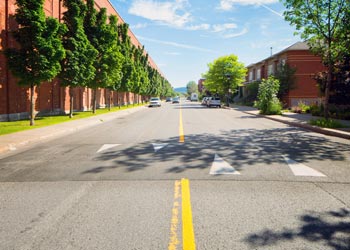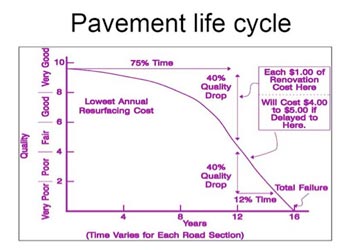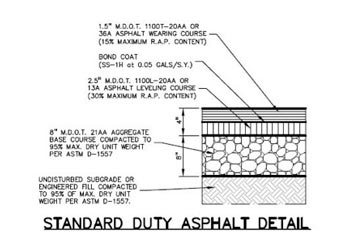
As many longtime Michigan residents know, there are two seasons in Michigan: winter and construction season. Since a particularly long and hard winter may have finally left us here in Michigan, it’s time to look at our asphalt paving.
Let’s start with what we should expect from our pavements. Like anything, pavements have a useful life. Most pavements in Michigan are designed to last around 15-30 years. Things that affect that lifespan are:
Ground Conditions
- Water (Surface runoff, Subgrade, Sprinkler)
- Subgrade (Not all clays are equal)
Original Design
- Was it adequate for ground conditions and loads (trash haulers)?
- Assuming this is a private road - as most association roads are
Original Construction
- Was it done well and per the design?
- Did the development of construction traffic affect the road?
- Were all the proper repairs made to the initial base course when the topping was put on?
Maintenance
- Was adequate maintenance done at the appropriate times?
The diagram below is a general illustration of a “typical” pavement life cycle.

The diagram illustrates what you may have observed about your own pavement. If perhaps it was “Fair” in the fall, it could have fallen into “Poor” condition over a very hard winter.
If your pavement is in the “steep” section of the graph, a bad winter (or two) will push it further faster down the “slope of the graph”.
When we are talking about pavement it is much more than just what we walk on. Pavement, concrete, or asphalt is a system. See Below Diagram.

In addition, the above- EDGE DRAIN, while not always present in the initial design of a private road, should be considered to be added where ground conditions are wet to help direct water to the low points (catch basins).
What can we look for and control?
- First, where are you in the life cycle?
- What has been done in the past and how is that working?
- What is the makeup of the existing paving at your site?
So, what to look for:
Catch basins: These are high maintenance items as they are the low point for water in the system. Most often they are constructed from brick and block, mortared together- the water and road salt works at the blocks and the mortar joints to cause failures. When redoing catch basins look at the option of putting edge drain in to help with subgrade water.
Hot Rubber Joint filling of cracks, at the appropriate times, is crucial to getting the most out of the paving. Hot rubber joint sealing is most effective on singular cracks. Once an area has started to “spider” or “alligator” crack, an asphalt repair will need to be considered. Once any given major section of pavement area is 30% or more of patching – as long as it remains tight, it may be better to look at removing and replacing an entire large area.
Sealcoating is a surface treatment that will fill in very minor surface voids and tiny hairline cracks too small for hot rubber joint sealing. In theory, it helps slow down the oxidization (drying) of the liquid asphalt that binds the stone to the asphalt paving.
Also, in parking areas, sealcoating acts as a barrier against oils and other fluids that are leaked by cars. In Michigan- because we most often have base issues rather than surface deterioration due to age, sealcoating has limited benefit for the preservation of the paving. Opinions differ but sealcoating is more aesthetic in value than structural, in Michigan.
Asphalt patching
There are different types of :
- Remove and Replace Patches: For areas that can be isolated and have “good” paving to tie into.
- Overlay Patching: Used for short term repairs (1-3 years) where you are planning on doing replacement or mill and cap within 3-5 years.
- Thermal Repairs: In Michigan, in our opinion, these are only good for surface corrections, as they typically only affect the top 1” or less of the existing paving.
- Mill and Overlay: Can be used for isolated areas but most often is used to extend the life of a larger area by milling or “planning” off a set depth of asphalt and replacing it”- reflective cracks will occur in this method and the depth of paving should be known- for instance if 3” of paving exists- milling off 2” generally won’t work as there is too little paving to build back on.
This brings up a question we hear frequently, “What do you think we need to “fix” in the parking lot?”. This is a subjective question and three qualified contractors could give 3 very different answers.
As the property owner, go back to the life cycle questions-, and ask yourself, ”Where are we now?” Add into that- “What can we afford now?” And, “What will the costs be to delay repair?
When an association is redoing paving, the most expensive repair is the wrong repair. When considering a major repair, many times, it is appropriate for the association to enlist the services of pavement engineers. Even if the major work is 3-5 years out, going this route will most often keep you from choosing the “wrong” repair.
A pavement engineer can assist an Association in three ways:
- Determining what the right repair is via cores and bores that go down within the zone of influence of the paving ( 4 feet) this will show not only pavement depth, but aggregate (stone) composition and depth, Subgrade composition and strength as well as moisture content.
- Putting specifications together from which a bid(s) can be obtained.
- Testing and inspection of the work for specification compliance and workmanship.
Best of luck in your spring walkthroughs!
Call Our Asphalt Contractors Today
If you need help with asphalt paving, repairing, sealcoating, striping, or more, our Michigan asphalt contractors will use their years of experience to get the job done right. Call one of our 4 Asphalt Construction locations in Clarkston, Brighton/Howell, Milford, or Lapeer, MI, today. Feel free to also contact us online for a free estimate.
This blog post has been updated.